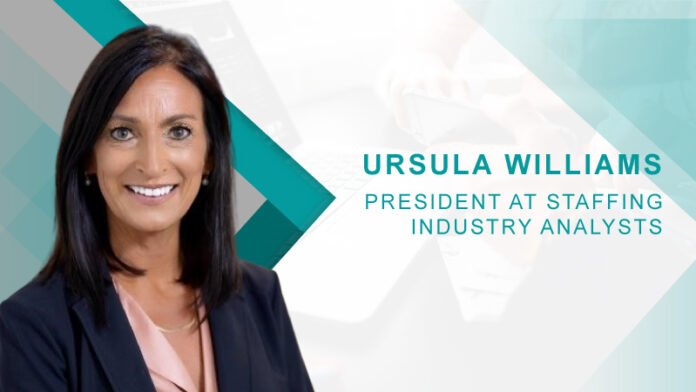Welcome to HRtech Cube, Ursula. To kick things off, can you please tell us about your professional journey and what led you to your current leadership role at Staffing Industry Analysts?
Thank you for speaking with me, HRtech Cube! My professional journey includes nearly three decades of staffing industry leadership overseeing strategy, sales and delivery for both subject matter experts and large contingent labor buyers. I have also been responsible for field and corporate level staffing operations, geographic expansion, new product development, branding, web strategies, technology, sales and talent recruitment programs.
As a former client of SIA, I developed a deep admiration for its business model and the pivotal role it plays in strengthening the staffing and workforce solutions ecosystem. Joining the company allowed me to channel a career’s worth of experience into an organization I truly respect, making it both a natural and inspiring next step in my executive journey.
I joined Staffing Industry Analysts (SIA) in 2015 as senior vice president of global strategy and marketing and then served as executive vice president. I was SIA’s chief operating officer from 2019 to 2024, and now I am the research and advisory firm’s president.
I have several highlights of my time since joining SIA. The company has more than doubled in size, growing 127%. I led a restructuring of the organization aligned with a renewed go-to-market strategy designed to elevate customer experience and optimize internal operations. I also built a strong, cross-functional leadership team, bringing in new executives across editorial, marketing, tech ops, and new business development along with internal promotions from memberships, advisory, research and strategic solutions.
More recently, I spearheaded the deployment of a modern technology infrastructure and a company-wide rebrand. In addition, I led the development of SIA’s award-winning Collaboration in the Gig Economy conference, now successfully evolved into CollaborationX.
SIA is preparing for the newly reimagined CollaborationX event this September. What inspired this transformation, and what should attendees expect from the updated format?
SIA’s Collaboration in the Gig Economy event has been reimagined as CollaborationX: AI & Tech in Staffing and Workforce Solutions. The evolution reflects the market’s shift beyond gig models toward a broader, tech-driven ecosystem. This isn’t just a new name; it’s a strategic step forward.
CollaborationX embodies the expanded scope, influence, and urgency of conversations as well as innovations happening across staffing firms, enterprise buyers and the entire workforce solutions ecosystem. Those innovations are fast forwarded by technology in addition to being fueled by AI.
Under the theme At the Intersection of Innovation, Intelligence, and Digital Transformation, CollaborationX 2025 takes place in Dallas, Texas from Sept. 9 through Sept. 11. Sessions will spotlight recruitment automation, platforms, AI-driven hiring tools, autonomous recruiting, digital labor supply chains, and emerging workforce technologies.
With AI rapidly reshaping workforce solutions, how have you seen staffing firms begin to embrace this shift — and what sets the most successful ones apart?
Artificial Intelligence has truly become ubiquitous across the staffing industry. SIA’s research shows an accelerated AI adoption pace over the second half of 2024 and into 2025, stimulated by the appearance of Agentic AI among other drivers.
SIA’s 2025 North America Internal Staff Survey found that 65% of internal staff indicate they are using AI to some degree and most find it helpful. Marketing staff lead AI adoption, with nearly 90% of staff reporting use, followed by C-suite executives.
AI is no longer viewed as a future possibility but as a practical tool driving real-time improvements in recruitment, productivity, and client delivery. Several global leaders are embedding AI directly into core operations to make their processes quicker, less expensive, more accurate, less biased, more informative, or even a combination of all of these.
SIA has released recent research on AI usage and the evolving talent platform landscape. What are the most impactful findings you’d highlight from these reports?
SIA Research Director Brian Wallins just published a great talent platform report with some key insights relating to AI.
-
- Skills Realignment. AI is influencing an evolving shift of skill categories. According to our survey data:
- Categories such as IT, engineering, finance & accounting, and sales & marketing appear to be directly benefiting or are at least shielded from AI-related headwinds.
- On the other hand, jobs in writing/translation, design, office/clerical, and legal are most negatively impacted.
- AI use cases. AI has long been featured in talent platform candidate matching algorithms and continues to be an important differentiator as matching becomes smarter and more dynamic.
- Skills Realignment. AI is influencing an evolving shift of skill categories. According to our survey data:
However, AI is quickly becoming integrated into nearly every major workflow on both sides of the marketplace. Examples of where AI is emerging or having the greatest impact include:
-
- Talent matching of known workers’ skills and availability
- Content generation
- Skills verification
- AI copilots to transform the entire user experience
- AI-enhanced analytics
- Freelance team formation
- Freelancer profile enhancement
- Project proposal generation
- Personal assistants to automate routine tasks
- Smart upskilling and/or reskilling
- Coding and design
How do you see AI improving efficiencies and transforming talent engagement in real, practical ways for staffing firms today?
Our May 2025 US Staffing Industry Pulse Survey Report showed that AI use has reached all departments to some degree, with the biggest in recruitment/talent acquisition. And this is consistent with our 2025 North America Staffing Company Survey.
When asked “In the next 3 years, which of the following do you estimate will have replaced 25% or more of current activities through AI?” respondents said:
- Writing emails and texts (53%)
- General research (41%)
- Finding optimal keywords and search strings (33%)
- Writing job descriptions and job postings (26%)
- Writing for marketing (18%)
- Writing/editing candidate resumes and presentations (12%)
- Candidate sourcing (10%)
- Identifying new clients, markets, products (9%)
- Candidate screening assessment (7%)
- Candidate engagement (5%)
- Other (5%)
With tech innovation moving so quickly, how can staffing leaders ensure they’re making the right tech investments without falling for short-term hype?
This is the million-dollar question! SIA completed a workshop during our Executive Forum North America conference earlier this year, and the most widespread tech challenge staffing firms are facing is selecting the right AI tools. A close second was implementing effective reporting and analytics technology, followed by integrating new tools with existing systems.
An important key to making the right decisions is identifying which solutions will have the greatest impact at the lowest cost — both in terms of dollars as well as in terms of time and internal disruption. Also important is identifying trusted partners that will keep up with the pace of change and demonstrate their investment in long-term successful client outcomes.
CollaborationX focuses on thought leadership and collaboration. What role does community and idea-sharing play in helping the industry evolve with tech?
You’ll notice that the word “collaboration” remains in our conference’s new name, and that is very intentional. Meeting the pivotal moment presented by staffing and workforce solutions’ technological revolution, SIA’s revamped conference is specially designed to bring together organizations and individuals seeking to be at the forefront of industry innovation.
CollaborationX connects staffing firms, workforce solutions leaders, technologists, investors, and enterprise buyers to discover how AI as well as other technologies are shaping workforce solutions in a unique, cross-industry environment. Only when we come together as a larger ecosystem and community, can we best explore and build on what is next — hence, the “X” in CollaborationX!
What’s one core personal strategy you use as a leader when navigating fast-changing landscapes like AI and digital transformation?
I am a growth-minded leader who values people and fosters a high-performance culture. Based in Silicon Valley, I view technology as a core driver of organizational strength and innovation.
I’m naturally curious, and in times of rapid technological change, my strategy is to quickly gather trusted insights while engaging deeply with innovators, solution providers, and domain experts. I like to fast-forward to envision what transformation could look like, then work backward to reimagine and reinvent our own business.
I start by identifying problems to solve, ranking them by effort and impact, and then bringing in the best people to tackle them. For me, this approach is both a discipline and a source of inspiration.
What advice would you give to staffing firms—especially smaller or mid-sized ones—looking to start integrating AI into their operations?
SIA has new research publishing soon that does show smaller staffing firms are falling behind in the AI race. By way of a sneak peek of those findings, I will share that only 28% of small staffing firms (less than $10 million in revenue) are using third-party AI-enhanced software. This is compared to 47% of large staffing firms (more than $150 million in revenue). There is great competitive risk in not exploring and pursuing AI capabilities.
If smaller firms are using an applicant tracking system (ATS), that is a logical place to start. Most ATSs are introducing new AI features, and the majority are seamlessly integrated. Firms should also commit to regularly testing and piloting new AI capabilities. This helps to not only determine business fit, but also to increase awareness of what is out there as well as deepen the understanding of what AI can do for their businesses.
Finally, any closing thoughts on what the future of staffing looks like as technology continues to reshape how we connect businesses with talent?
One focus of CollaborationX is on how tech such as AI is changing the industry. Some tasks are better suited to being performed by technology than by humans. New entrants into the market are bringing the latest technology and new ways of operating. Talent is becoming more comfortable with technology, such as using mobile apps to find jobs.
Staffing is already transforming with staffing firms resembling tech companies, connecting talent and work 24/7 with volume, speed and quality. We’re seeing the rise of autonomous recruiting firms, talent platforms, and widespread adoption of staffing platforms by the largest players.
At the same time, background checks, screening, and credentialing are being streamlined through technology and automation. Middle and back offices are scaling more efficiently, and the result is a much more elevated level of service with increased productivity for all involved.
The progression of tech doesn’t have to be viewed as upheaval or a stealer of jobs. Instead, view technological advances as transformation and enrichment. The digital transformation is simply about employing enhanced ways of working.
Sources
- Listed Staffing Company Trends Analysis 2025
- North America Internal Staff Survey 2025: Use of AI by Task, Perception of AI Helpfulness, and Requests to Management
- Staffing Trends 2025
- US Staffing Industry Pulse Survey Report: May 2025

Ursula Williams President at Staffing Industry Analysts
Appointed president of Staffing Industry Analysts (SIA) January 2024, Ursula Williams has overall responsibility for the company’s global strategy, operations and growth. She has nearly three decades of industry leadership with extensive experience in the staffing and workforce solutions industry. Williams is a member of the US Staffing Leadership Council, part of the Women Business Collaborative (WBC), and co-author of Together We Rise. She is also part of the executive leadership team for SIA’s parent company, Crain Communications.












